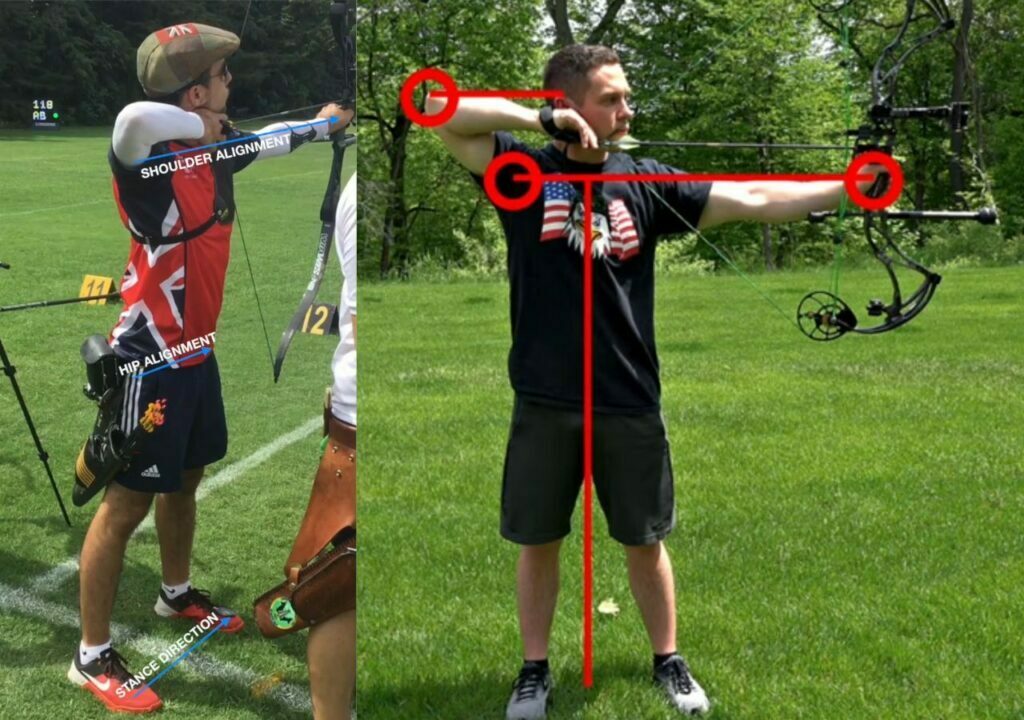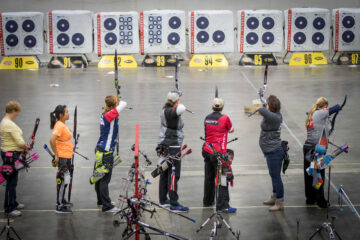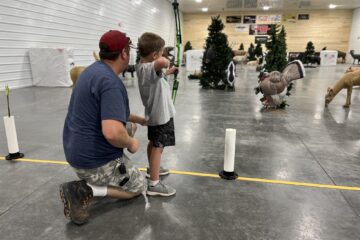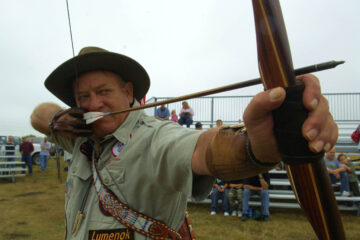Have you ever tried archery and found yourself struggling with your archery form? Don’t worry, you’re not alone! Even experienced archers can struggle with maintaining proper archery form. That’s why I’m here to share with you the Top 10 Tips for Improving Your Archery Form.
Whether you’re a beginner or an advanced archer, these tips can help you refine your technique and improve your accuracy. So, without further ado, here are the steps to take.
- Start Archery Form With a Proper Stance and Posture
- Focus on Your Grip and Hand Placement
- Learn to Anchor Your Draw Hand Consistently
- Ensure Your Elbow is in the Correct Position
- Use Your Back Muscles to Draw the Bowstring
- Keep Both Eyes Open While Aiming
- Work on maintaining a steady aim
- Release the bowstring smoothly and consistently
- Follow Through with Your Shot
- Practice consistently and with purpose
Start Archery Form With a Proper Stance and Posture
When it comes to archery, your stance and posture are the foundation for a successful shot. A proper stance will allow you to maintain your balance, distribute your weight evenly, and have good control of your movements.
First, start with your feet shoulder-width apart and perpendicular to the target. This will provide a stable base to shoot from. Your body should be facing the target directly, and your shoulders should be relaxed with your chest slightly forward. Keep your head level and avoid any unnecessary movements.
It’s important to note that there are different types of stances, depending on your preference and shooting style. The most common stances are the square stance, where your feet are parallel to the target, and the open stance, where your front foot is slightly forward.

Experiment with different stances to find what works best for you, but always make sure to maintain proper alignment with the target.
Additionally, posture is crucial for maintaining a consistent shot. Keep your back straight and avoid leaning forward or backward. This will help you maintain good balance and allow for smoother, more consistent movements.
Remember, starting with a proper stance and posture is the first step in achieving accuracy and consistency in archery. Take the time to practice and experiment with different stances and postures to find what works best for you.
Focus on Your Grip and Hand Placement
Once you have a proper stance and posture, the next step is to focus on your grip and hand placement. A consistent and comfortable grip will help you maintain control of the bow and achieve a smoother shot.
When gripping the bow, your hand should be relaxed and lightly cupping the grip. Avoid gripping too tightly, as this can cause tension and affect your shot. Instead, focus on having a comfortable grip that allows for a smooth and natural release.
Your hand placement is also important. Place the bow grip in the webbing between your thumb and index finger, and make sure your fingers are not interfering with the bowstring. Your other hand, the one holding the bowstring, should also have a consistent and comfortable placement. Experiment with different hand placements to find what works best for you, but make sure to keep it consistent for every shot.
One helpful tip is to imagine that you are holding a bird in your hand. You want to hold it gently enough so that it doesn’t fly away, but not so tightly that you harm it. This same concept applies to your grip on the bow – hold it gently, but with enough control to maintain a consistent shot.
By focusing on your grip and hand placement, you will have greater control over your bow and be able to achieve a smoother and more accurate shot. Take the time to practice and experiment with different grips and hand placements until you find what works best for you.
Learn to Anchor Your Draw Hand Consistently
Anchoring is an important aspect of archery form that can greatly impact your shot accuracy. Anchoring refers to the consistent placement of your draw hand on your face or chin while aiming. By anchoring in the same spot every time, you can achieve a more consistent shot.
To find your anchor point, start by placing your bow hand in the correct position, with your elbow slightly bent and pointed downward. Draw the bowstring back to the corner of your mouth, and feel for a natural spot on your face or chin where your draw hand can consistently rest. This spot should be comfortable and easy to find every time.
Once you find your anchor point, make sure to consistently anchor in that same spot for every shot. This will help you achieve a more consistent release and ultimately lead to more accurate shots.
One helpful tip is to use a reference point, such as the corner of your mouth or a facial feature, to ensure consistent anchor placement. This will also help you maintain proper alignment with the target.
By learning to anchor your draw hand consistently, you can achieve greater shot consistency and accuracy. Take the time to find your anchor point and practice anchoring in that same spot for every shot. With practice, anchoring will become second nature and greatly improve your archery form.
Ensure Your Elbow is in the Correct Position
Your elbow position is another important aspect of your archery form. Proper elbow position helps ensure that you are using the correct muscles to draw the bowstring and maintain a consistent shot.
To ensure proper elbow position, start by positioning your bow arm with a slight bend in the elbow, pointed downward. This will help you keep your elbow out of the way of the bowstring during the shot. As you draw the bowstring back, make sure your elbow stays in this position and doesn’t flare out to the side or up toward your ear.
A common mistake is to “chicken wing“ your elbow, which means your elbow flares out to the side during the shot. This can cause inconsistency in your shots and even lead to injury over time. Keeping your elbow in the correct position will help you avoid this issue.
To help keep your elbow in the correct position, focus on using your back muscles to draw the bowstring, rather than relying on arm strength alone. This will help you maintain proper alignment and prevent your elbow from flaring out.
Overall, proper elbow position is crucial for maintaining a consistent shot and preventing injury. Take the time to ensure your elbow is in the correct position during every shot, and focus on using your back muscles to draw the bowstring. With practice, proper elbow position will become second nature and greatly improve your archery form.
Use Your Back Muscles to Draw the Bowstring
Using your back muscles to draw the bowstring is one of the most important aspects of proper archery form. When done correctly, it will help you achieve a smooth and consistent shot every time.
To properly use your back muscles, start by standing with good posture and a relaxed, open stance. As you begin to draw the bowstring, focus on pulling your shoulder blades together and down your back, which will engage your upper back muscles. Avoid using your arms to pull the bowstring back, as this can lead to fatigue and inconsistency.
As you continue to draw the bowstring back, focus on using your lower back muscles to complete the draw. This will create a smooth and fluid motion, and help you avoid jerking or over-drawing the bowstring.
A helpful analogy is to imagine you are rowing a boat. Just like in rowing, you want to use your back muscles to pull the bowstring back smoothly and efficiently, rather than relying on arm strength alone. This will help you maintain proper form and prevent injury.
Remember, using your back muscles to draw the bowstring takes practice and patience. It may feel awkward at first, but with time and dedication, it will become second nature. By using your back muscles to draw the bowstring, you will greatly improve your archery form and enjoy more consistent and accurate shots.
Keep Both Eyes Open While Aiming
One of the most common mistakes archers make is closing one eye while aiming. While this may seem like a natural instinct, it can actually hinder your accuracy and depth perception.
Keeping both eyes open while aiming allows your brain to process more visual information, which can help you better judge distances and adjust your aim accordingly. It also helps prevent eye strain and fatigue, which can affect your focus and concentration.
To keep both eyes open while aiming, start by focusing on your target with your dominant eye. Then, without shifting your gaze, bring your bow up and into position, using your non-dominant eye to align the bowstring with the target.
If you find it difficult to keep both eyes open, try using a blinder or patch over your non-dominant eye. This will help you maintain your focus on the target while still allowing you to use both eyes for depth perception.
An analogy for this technique is to think of it like driving a car. When you drive, you use both eyes to judge distance and adjust your position on the road. Archery is similar in that it requires depth perception and visual processing to achieve accuracy.
Remember, keeping both eyes open while aiming takes practice and patience. But with time, it can greatly improve your accuracy and overall archery form.
Work on maintaining a steady aim
Maintaining a steady aim is critical to hitting your target consistently. Without a steady aim, your shots will be unpredictable and off-target. Here are some tips to help you maintain a steady aim:
- Focus on your breathing:
Take deep breaths and exhale slowly. This helps to calm your nerves and keep your aim steady.
- Use a sight:
A sight helps you aim your bow more accurately. Make sure the sight is properly aligned with your bowstring and the target.
- Keep your grip steady:
If your grip is too tight, it can cause your bow to wobble. Try to keep your grip relaxed, but firm enough to hold the bow steady.
- Avoid jerky movements:
Any sudden movements can throw off your aim. Move slowly and deliberately, and focus on keeping your bow steady throughout the shot.
By practicing these techniques, you can develop a steady aim and improve your accuracy over time.
Release the bowstring smoothly and consistently
Releasing the bowstring is the final step before your arrow takes flight. A smooth and consistent release can make all the difference in the accuracy of your shot. Here are some tips to help you release the bowstring properly:
- Relax your fingers:
Before releasing the bowstring, ensure that your fingers are relaxed. Do not grip the bowstring too tightly as it can cause the arrow to wobble and deviate from its intended path.
- Use your back muscles:
As you draw the bowstring, focus on using your back muscles to maintain tension in the bowstring. This will make it easier for you to release the bowstring smoothly and consistently.
- Follow-through:
Follow-through is critical to ensure that the arrow hits the target where you intended it to. After releasing the bowstring, continue to aim and hold your bow steady until the arrow hits the target. This will help you develop consistency and accuracy in your shots.
- Practice:
Releasing the bowstring smoothly and consistently takes practice. The more you practice, the more you will develop muscle memory, which will help you release the bowstring smoothly and consistently with each shot.
Remember, the key to releasing the bowstring smoothly and consistently is to stay relaxed, use your back muscles, and follow through. With practice, you will be able to release the bowstring with ease, resulting in accurate shots.
Follow Through with Your Shot
The follow-through is the final part of the shot execution, and it’s crucial to complete the shooting process properly. Here are some tips to help you follow through correctly:
- Hold Your Position:
After releasing the string, maintain your bow arm and body position. Don’t move or shift your weight until the arrow hits the target. This will help you evaluate your shot and improve your consistency.
- Maintain Tension:
Keep your bow hand in place after the shot, even if your draw hand moves forward. This will maintain tension on the bowstring, which can help improve your accuracy and consistency.
- Don’t Drop Your Bow:
Avoid dropping your bow or relaxing your grip immediately after the shot. This can cause the arrow to deflect and miss the target. Instead, maintain your grip until the arrow hits the target.
- Evaluate Your Shot:
Pay attention to where your arrow lands, and use that information to make adjustments to your form or aim as necessary.
- Practice Consistently:
Consistent follow-through requires practice, so make sure to include it in your training regimen.
By following through correctly, you’ll not only improve your accuracy and consistency but also reduce the risk of injury. So remember to hold your position, maintain tension, avoid dropping your bow, evaluate your shot, and practice consistently.
Practice consistently and with purpose
Great job! You have learned a lot about the basics of archery form and technique. But remember, mastering these skills takes practice and dedication. Here are some tips for practicing consistently and with purpose:
- Set a goal for each practice session
Whether it’s hitting a specific target, improving your groupings, or perfecting your form, having a specific goal in mind will help you stay focused during your practice session.
- Practice regularly
Consistency is key when it comes to improving your archery skills. Try to practice at least once a week, if not more often.
- Focus on quality over quantity
It’s better to practice for a shorter amount of time with purpose and focus than to practice for a longer period without a plan or goal.
- Mix up your practice routine
Try shooting from different distances, angles, and positions. This will help you develop a well-rounded set of skills and keep your practice sessions interesting.
- Get feedback from others
Having a coach or more experienced archer watch and critique your form can be invaluable in identifying areas for improvement.
- Keep a log of your progress
Tracking your progress over time can be a great motivator and help you see how far you’ve come.
Remember, the key to mastering archery is to stay patient, stay focused, and keep practicing. With time and dedication, you’ll be hitting bullseyes in no time!






